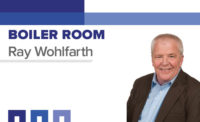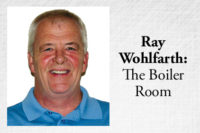For example, to lower installation costs, an installer and designer chose to reuse the existing Category III stack, which meant it was a noncondensing, positive static pressure flue. The new boiler called for a Category I, which was noncondensing with a negative static pressure. After about two heating seasons, the Category III flue collapsed into itself because it was not designed to operate in a negative condition. It was like a beer can being squeezed after consumption.
It was a legal mess and could have been a dangerous situation. The entire flue had to be replaced at the expense of the installer and designer.
If you are reusing the existing flue, verify the size and category are correct. The following is a list of the flue categories that are used for venting boilers:
• Category I — Appliance operates with a negative vent static pressure at temperatures above condensing temperatures. Typical efficiency range is 78% to 83%.
• Category II — Appliance operates with a negative vent static pressure at or below condensing temperatures. Typical efficiency range is more than 85%.
• Category III — Appliance operates with a positive vent static pressure at temperatures above condensing temperatures. Typical efficiency range is 78% to 83%.
• Category IV — Appliance operates with a positive vent static pressure at temperatures at or below condensing temperatures. Typical efficiency range is more than 90%.
Confirm the size of the flue the old boilers were using. If the old boiler had a draft hood, the flue may be oversized when using a power burner. I suggest making a diagram of the existing flue and consult a venting specialist when reusing the existing flue.
May I have some more?
When I was young, my parents took me to see the musical “Oliver,” which was about the adventures of a young orphan in London based on Charles Dickens’ book “Oliver Twist.” If you are removing the boiler flue from the chimney and venting it through the wall, be wary of “orphans.” When you remove the boiler venting and leave the existing water heater or pool heater in the old chimney, it is referred to as an orphan.
This is where the Seven Times Rule comes into the play, which is: The flow area of the largest common vent or stack shall not exceed seven times the area of the smallest draft hood outlet. Since most water heaters use a 3-in. flue, the largest area to connect the water heater should be 49 in. or a 7-in. round one. You may have to change the venting of the old water heater or install a flue liner for it. The round flue chart shows the largest common round flue that each can be connected to.
If you are connecting to a square or rectangular chimney, you will need to estimate the area. The rectangular flue chart shows the sizes the vent can be connected to.
For example: You remove the boilers from a square chimney that is 12 in. by 12 in. and want to see if you can leave an old water heater with a 4-in. flue outlet. The chimney is 144 in. This is greater than the rule of seven sizing for the 4-in. flue, which is 87.92 in. On this job, you would have to make provisions for the water heater flue. A chimney liner would most likely have to be installed here. You will need to have the price for that in your estimate or design. Without the chimney liner, the flue gases could condense, ruining the chimney.
Horizontal vs. vertical
Another rule to remember is the horizontal vents must be no more than 75% of the vertical height of the flue. If using B vent, the horizontal length can be the same length as the height of the chimney, as per the International Fuel Gas Code, 2006 503.10.9.
How tall is the chimney? If you have ever been to a boiler room that once housed a coal-fired boiler, the chimney is really tall. I have a theory that the reason these chimneys were so tall was to spread the coal ashes over a wider area. These stacks take forever to heat high enough to sustain draft. Once warm, the draw is tremendous.
I once had the chimney draft pull off the ball cap I was wearing when I poked my head in to look. If you are connecting your new boiler to this dinosaur, there could be some real issues. The boiler flue gases could condense until the stack gets warm, causing rollout. Once the stack is warm, the draft could be very high.
A good rule of thumb is that a draft control should be used if the chimney is more than 30–ft. high. The draft control may range from a barometric damper to a sequencing draft control. It is not uncommon for Category I boilers to have flue gas spillage in the first one or two minutes when firing into a cold stack or chimney. A spill switch should be installed in the event of flue blockage.
Always stay safe.




